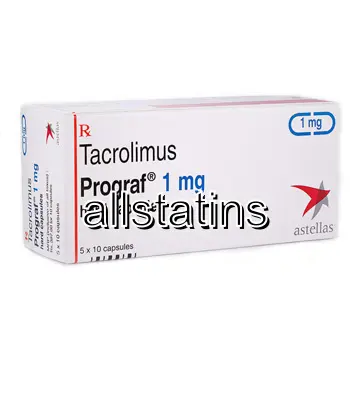| Package | Dosage | Price | Price per Dose | |
|---|---|---|---|---|
| Dosage: 0,5mg | ||||
| 90 pill | 0,5mg | $638.65 | $7.09 | |
| 60 pill | 0,5mg | $453.86 | $7.57 | |
| 30 pill | 0,5mg | $252.94 | $8.43 | |
| 20 pill | 0,5mg | $177.59 | $8.88 | |
| 10 pill | 0,5mg | $95.06 | $9.58 | |
| Dosage: 1mg | ||||
| 90 pill | 1mg | $896.98 | $9.97 | |
| 60 pill | 1mg | $642.23 | $10.71 | |
| 30 pill | 1mg | $378.52 | $12.59 | |
| 20 pill | 1mg | $281.64 | $14.06 | |
| 10 pill | 1mg | $157.85 | $15.86 | |
| Dosage: 5mg | ||||
| 20 pill | 5mg | $855.72 | $42.75 | |
| 10 pill | 5mg | $478.98 | $47.88 | |

Tacrolimus Description
Overview of Tacrolimus
Tacrolimus is an immunosuppressive medication widely used in organ transplantation procedures to prevent rejection. It is also prescribed to treat certain autoimmune conditions, helping to control the immune system's response. The drug works by inhibiting specific immune system cells, thereby reducing inflammation and immune activity. Tacrolimus is available in various forms, including capsules, topical ointments, and injectable solutions, making it a versatile option for different medical needs.
How Tacrolimus Works
Essentially, tacrolimus blocks the activity of T-lymphocytes, which are crucial in mounting an immune response. By binding to a protein called FK-binding protein (FKBP), tacrolimus inhibits calcineurin, an enzyme necessary for activating T cells. This suppression prevents the production and release of cytokines such as interleukin-2, which are vital for T-cell proliferation. The result is a significant decrease in the immune system's ability to attack transplanted organs or tissues, thereby lowering the risk of rejection.
Uses and Benefits
The primary use of tacrolimus is in organ transplant patients, including kidney, liver, and heart transplants. It helps improve the success rates of transplants by maintaining the immune system in a suppressed but controlled state. Besides transplantation, tacrolimus is also used topically for skin conditions like eczema and dermatitis, especially when traditional therapies are ineffective. Many patients find tacrolimus effective in controlling their symptoms and reducing flare-ups, making it a valuable addition to their treatment regimen.
Potential Side Effects and Risks
While tacrolimus is effective, it is not without potential side effects. Common adverse reactions include neurological symptoms such as headaches, tremors, and confusion. Gastrointestinal issues like nausea, diarrhea, and abdominal pain are also reported. More serious risks involve kidney impairment, high blood pressure, and an increased chance of infections due to immune suppression. Long-term use may raise concerns about possible malignancies, including skin cancers. Patients on tacrolimus should be monitored regularly by healthcare providers for any adverse effects or signs of toxicity.
Usage and Dosage
The dosage of tacrolimus varies depending on the condition being treated, patient weight, and response to therapy. It is crucial to follow the prescribing instructions carefully and to undergo routine blood tests to monitor drug levels and organ function. For transplant patients, medication schedules are typically strict to ensure optimal immune suppression while minimizing side effects. Patients should not alter their dosage without consulting their healthcare professional.
Conclusion
Tacrolimus remains a cornerstone in preventing organ rejection thanks to its potent immunosuppressive properties. When used appropriately, it offers significant benefits for patients, especially in transplantation contexts. However, due to its side effect profile, close medical supervision is essential. Patients should be aware of the importance of adherence to prescribed doses and regular monitoring to maximize benefits and reduce risks. Overall, tacrolimus offers an effective solution for those needing immune system modulation, supporting better outcomes in complex medical treatments.

